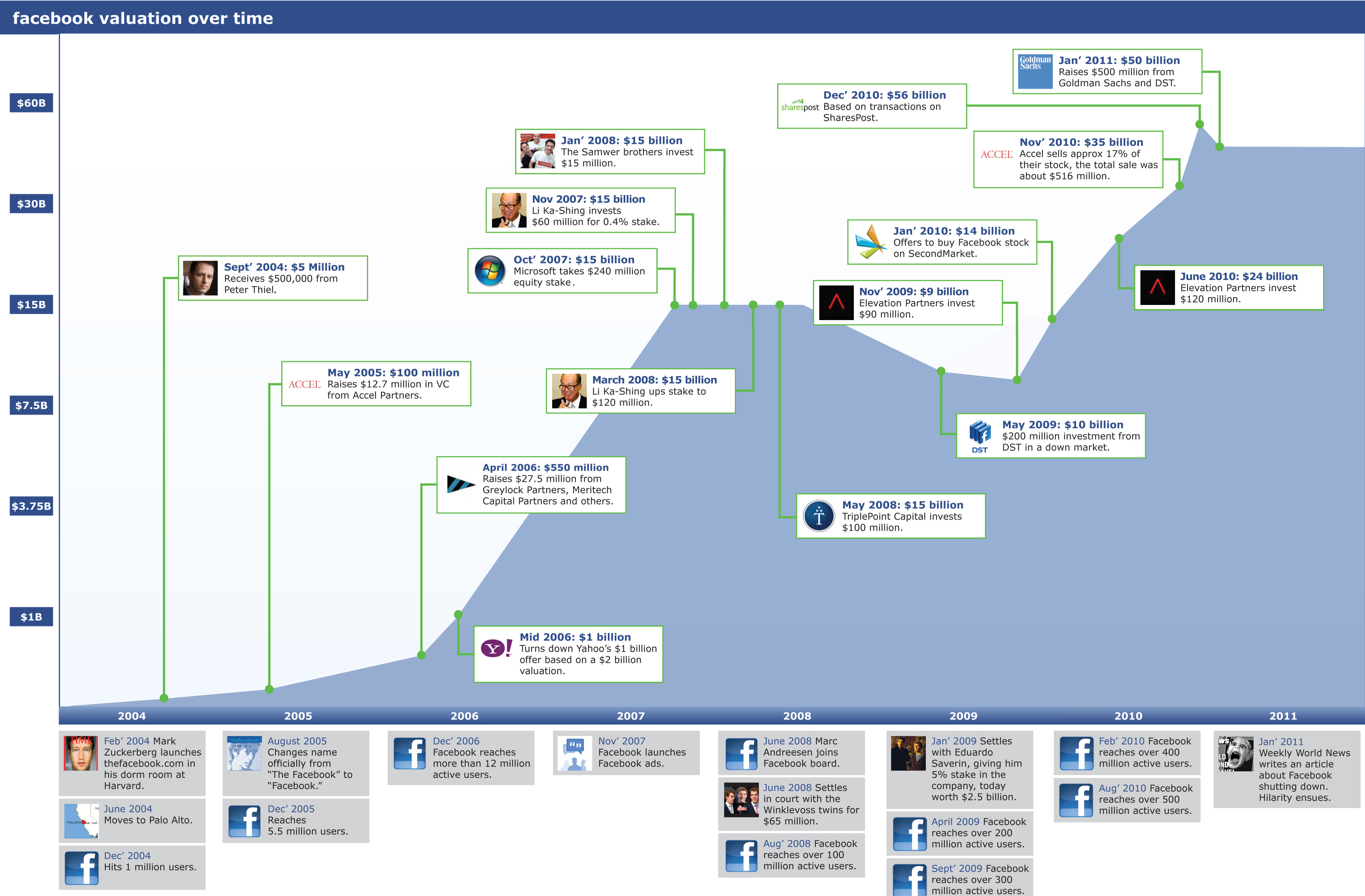ACCT 101: Financial Statements; Equity
Session 3
Dr. Richard M. Crowley
Frontmatter
Frontmatter
- Homework 1 should be submitted soon
- Submit on eLearn if you haven’t
- Homework 2 due next week
- Looking through real annual reports
- Somewhat open ended and will be graded for completion
- Look for it on eLearn
Learning objectives
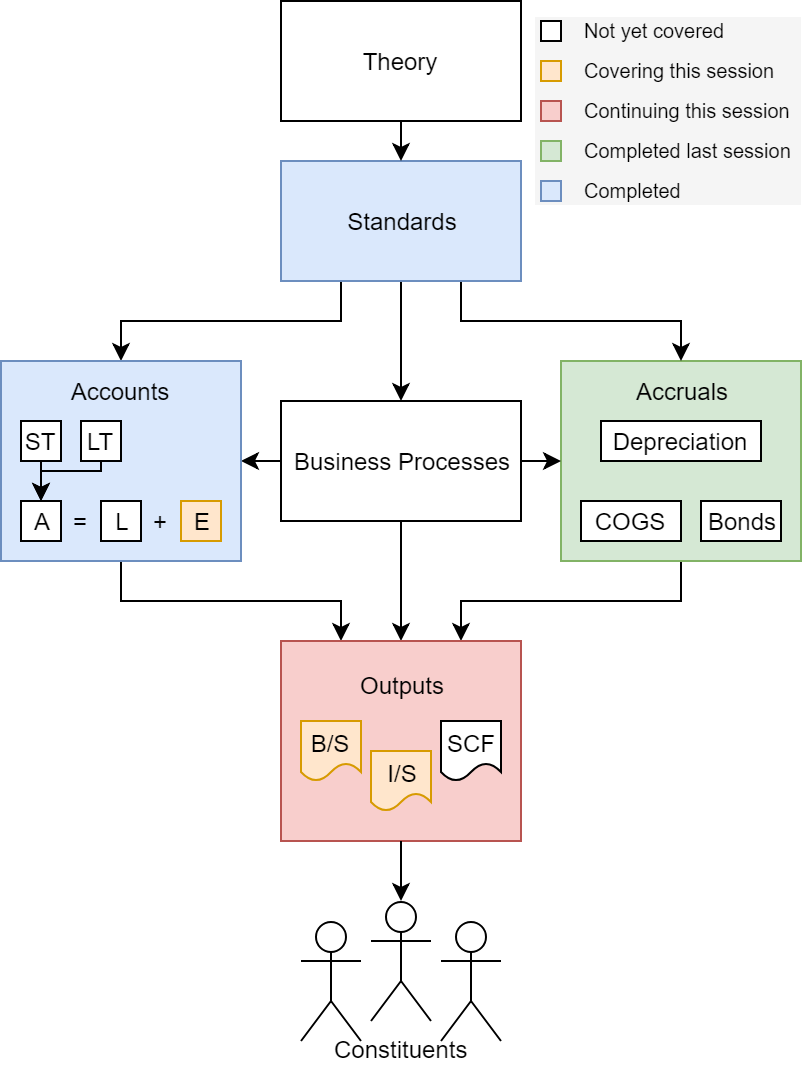
Financial Statements (Ch 3)
- Appreciate annual reports as a communication tool
- Understand the presentation of the Statements of:
- Financial Position
- Comprehensive Income
- Changes in Equity
Equity (Chapter 10)
- Learn about the share structure of a corporation
- Account for changing capital structure and dividends
Annual reports
What’s included
- Corporate information
- Name(s), history, key management/directors, structure
- Awards, company description, operating statistics
- Letter to shareholders
- Written by CEO
- Management Discussion and Analysis (MD&A)
- Management writes this section
- Often discuss:
- The year’s performance
- Possible future risks
What’s included
- Explicit and unreserved statement of compliance to financial reporting standards.
- Accounting statements
- Statement of financial position
- Statement of comprehensive income
- Statement of changes in equity
- Statement of cash flows
- Statement notes
- Often quite long, substance focused
- Discusses important but difficult matters
- Cannot rectify inappropriate accounting treatments
- Acknowledgement of responsibility by management
Why are these important?
- If you ever need information about a company’s financial standing, the annual and quarterly reports are your primary source.
- If you get information elsewhere (Bloomberg, Morningstar, etc.)…
- They got it from there
- Or from someone else who got it from there
- They got it from there
- Contains a lot of other useful information about the companies
What you can find
- Financials
- Risks to the company going forward
- Legal issues
- Corporate strategy
- The company’s major customers
- Good for checking out competitors…
- Plenty more!
Case: A good report (DBS)
Case: A bad report (Groupon)
We use adjusted consolidated segment operating income, or Adjusted CSOI, and free cash flow as key non-GAAP financial measures. Adjusted CSOI and free cash flow are used in addition to and in conjunction with results presented in accordance with GAAP and should not be relied upon to the exclusion of GAAP financial measures.
Financial statements
General requirements
- Name of reporting entity, date ended, currency used, level of rounding
- Or individual entity (“Consolidated report for…”)
- Can group similar accounts together if immaterial
- Not disclosing separately has no impact on F/S users
- Cannot offset liabilities with assets, unless allowed
- IAS 16, IAS 18
- Foreign exchange gains and losses
- Must be done at least yearly (fiscal year)
- Usually provide comparative information for the past two periods
Statement of financial position
- Also known as a balance sheet
- Presents:
- Non-current assets (> 1 year in life)
- PP&E, Inventories, Intangible assets
- Current assets
- Cash (and equiv), trade, other financial assets, biological assets, inventory, receivables
- Long term (> 1 year until paid off), then current liabilities
- Provisions, other financial liabilities
- Equity
- Non-controlling equity interests, issued capital, reserves
- Retained earnings
- Non-current assets (> 1 year in life)
Presents companies’ stock of assets, liabilities, and equity
How to construct a SFP
- Start with an adjusted trial balance
- List all long term assets and sum
- List all short term assets and sum
- Total all assets
- List all long term liabilities and sum
- List all short term liabilities and sum
- Total all liabilities
- List retained earnings
- List capital accounts
- Total all equity accounts
- Sum Total liabilities and equities
- Verify \(A = L + E\)
- Frequently include past year’s amounts in a second column
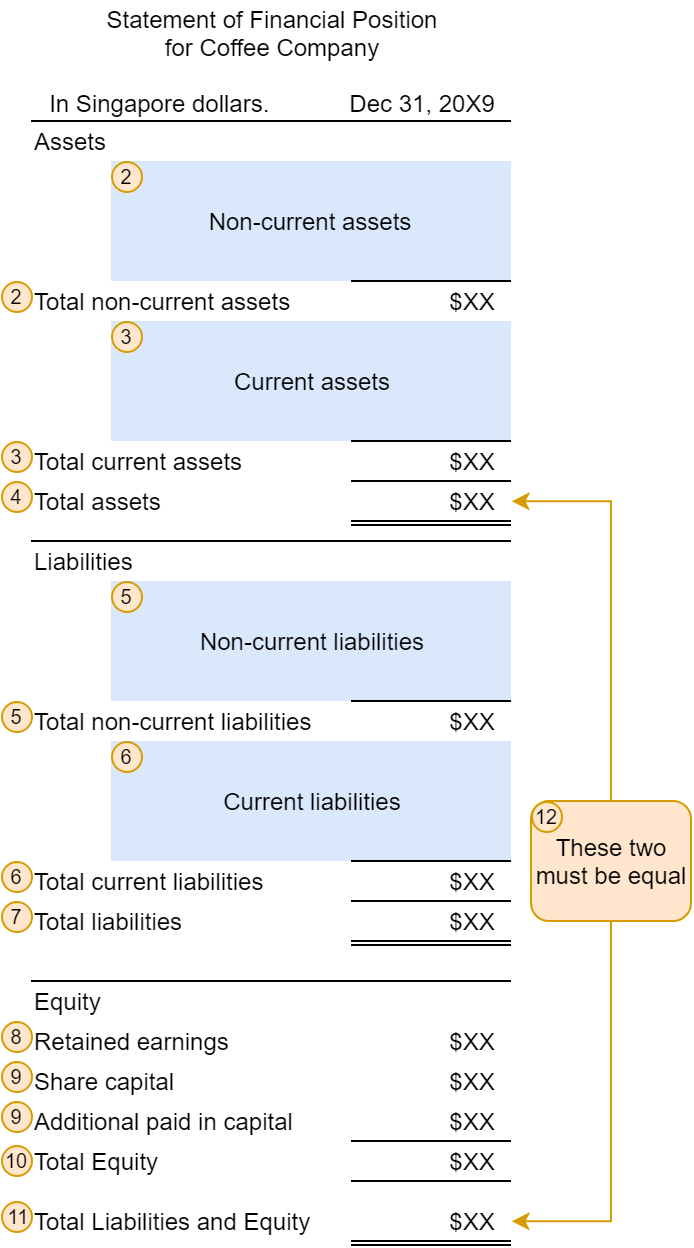
Statement of Comprehensive Income
- Also known as an Income Statement
- Presents:
- Revenue
- Expenses, categorized by nature or function
- Operating expenses
- Non operating expenses
- Net income
- Below or separately it presents:
- Gains and Losses
- Called other comprehensive income (OCI)
While taxes are always included, you will not be asked to calculate taxes for this course. If no taxes are mentioned, assume they are 0.
Constructing an SCI
- Start with an adjusted trial balance
- List revenue
- List cost of goods sold (COGS)
- Calculate gross profit (revenue - COGS)
- List other expenses (except interest and taxes)
- List other revenues (except interest and other holdings)
- Calculate operating profit
- List other non-tax expenses and incomes
- That aren’t included above
- Calculate income before taxes
- List taxes
- Calculate net income (loss)
- (Optional) start a new page
- List OCI items (gains and losses)
- List tax on OCI
- Calculate OCI, net of tax
- Calculate total comprehensive income
- OCI, net of tax + net income (loss)
- Often includes the prior year as well
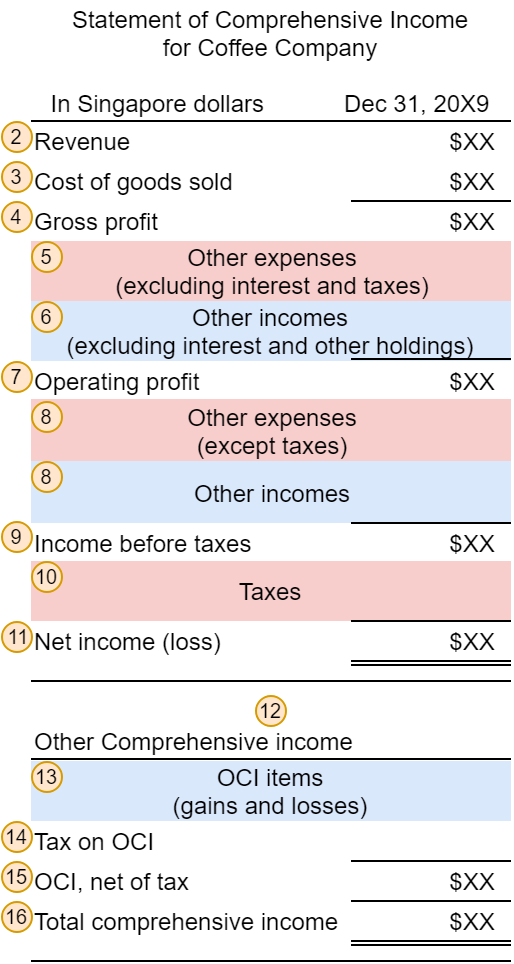
Statement of Changes in Equity
- Reconciles from period start to end
- Per IAS 1,must reconcile each equity item separately as well as the total
- Shows all transactions with owners
- Shows all dividends paid (can be as a note)
- This statement often relies on information that is contained outside the adjusted trial balance
You won’t be required to construct this statement for exams.
Constructing an SCE
- List all equity items across the top as columns
- Generally includes: share capital, APIC, retained earnings, treasury stock, total equity
- Put “balance as of [beginning date]” as the first row
- List all items that effected 1 of the columns values for the year as the rows
- Generally includes: share issuance, treasury share sales, dividends paid, net income
- Put “balance as of [ending date]” as the last row
- Fill out all changes
- Often includes the prior year as well
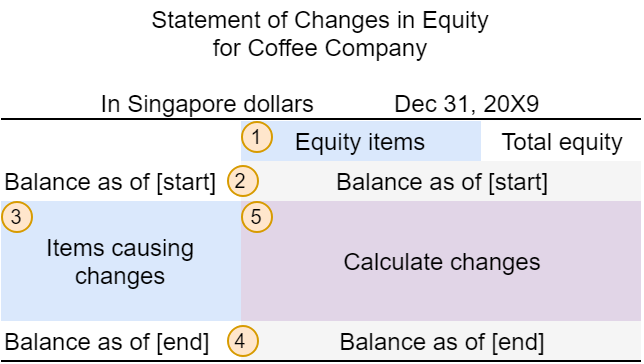
Statement of Cash flows
- We’ll get back to this…
- Sessions 10 and 11
- Chapter 11
Practice
- Practice problem on eLearn for Coffee Corp (last week’s company)
- Construct a Statement of Financial Position
- Use the adjusted trial balance
- Do for both years
- Construct a Statement of Comprehensive income
- Use the adjusted trial balance
- Do for both years
- Ignore taxes
There is an Excel file on eLearn with the adjusted trial balances for 20X8 and 20X9.
Financing
Financing types
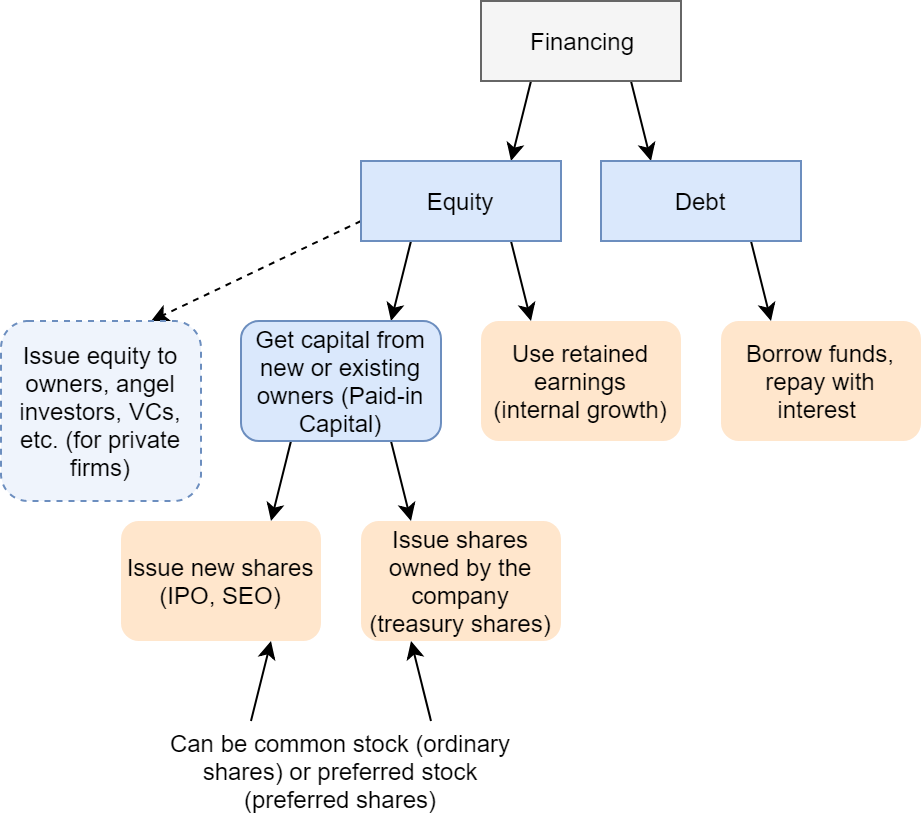
Equity vs debt
Equity:
- Advantages:
- No legal obligation to distribute profits
- Great for growth
- All profit can be reinvested
- No legal obligation to distribute profits
- Disadvantages:
- Dilutes existing shareholders’ ownership
- Decreases the % of the company they own
- More expensive
- Can only be issued by a corporation
- Dilutes existing shareholders’ ownership
Debt:
- Advantages
- Shareholders maintain ownership
- Can be quicker to receive financing
- Disadvantages
- Often need to pay periodic interest
- Requires cash on hand to pay
- Solvency risk \(\Rightarrow\) bankruptcy
- Often need to pay periodic interest
Articles of Incorporation
- Equity is governed by a coproations articles of incorporation
- Also known as a corporate charter
- Written at the time of incorporation
- When the company is created
- Governs:
- Nature of business activities
- NUmber of shares of stock
- Intial board of directors
Corporations
Advantages
- Can raise both equity and debt
- Continuous life
- Ownership is liquid
- Limited liability for owners
Disadvantages
- Separation of ownership and management
- Leads to conflicts of interest
- Other tax policies apply
- Double taxation: A corporation’s income is taxed and dividends to investors are taxed
- Generally not an issue in Singapore
- Double taxation: A corporation’s income is taxed and dividends to investors are taxed
- More government regulation
Corporations
Public
- Public investment
- No cap on # of shareholders
- Increased reculation



Private
- No public investment
- Some exceptions to this
- Fewer shareholders
- Less regulated



Share types
Ordinary shares
- Standard share type (most common)
- Has the four basic shareholder rights
- Benefits the most if the company succeeds
- Takes on the most risk
Preferred shares
- Limited/no voting rights
- Earns a fixed dividend
- Receives dividends before common shares
- Receives assets before common shares in liquidation
- May have other rights (convertible, redeemable, cumulative)
- Varies from company to company
Shareholder rights
Voting
- For board of directors
- For important events
Dividends
- Right to share in profits (when dividends are declared)
Liquidation
- Right to share in asset value if company liquidates
- After lenders get their share of value
Limited liability
- Can only lose what was originally invested
How shareholders protect themselves
Equity details
- Corporate charter stipulates the number of shares
- Rare that a company has all such shares issued
- Investors hold shares
- The company holds treasury shares
- Shares the company has bought back
- Unissued shares have never been issued
- Can issue in an Initial Public Offering (IPO) or Secondary/Seasoned Equity Offering (SEO)
- Requires government and exchange approval
- Can issue in an Initial Public Offering (IPO) or Secondary/Seasoned Equity Offering (SEO)
Number of shares
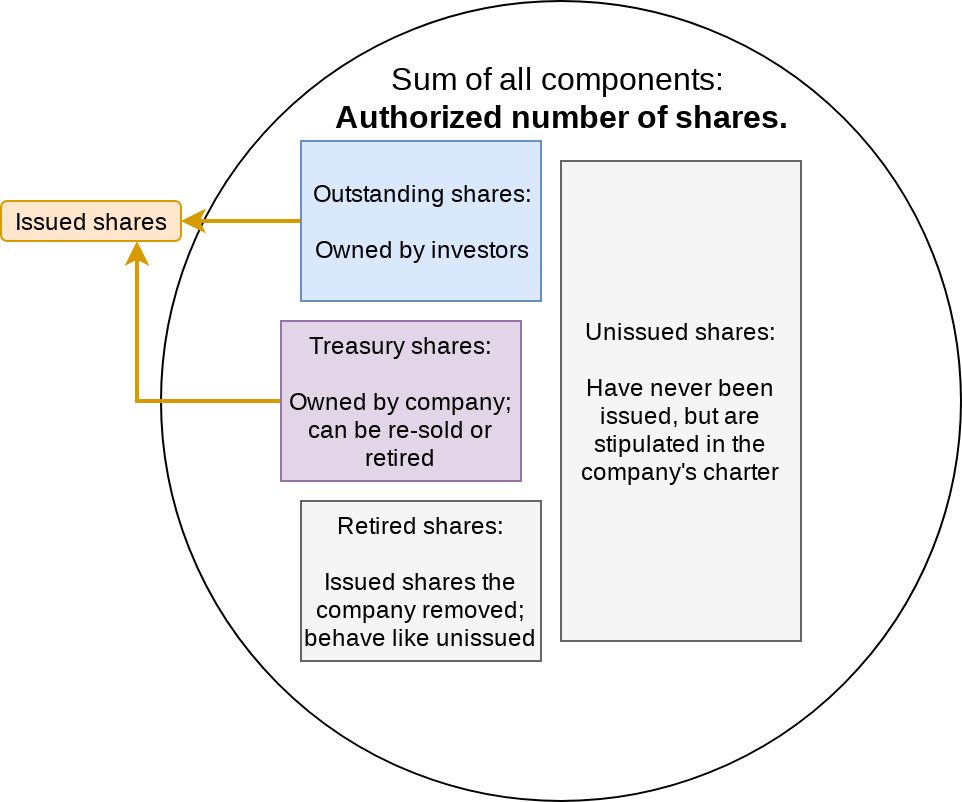
Equity financing example: Facebook
Accounting for Equity
Issuing shares
- Companies can issue shares from treasury or unissued shares
- Factors in issuing shares:
- Company’s current health
- Company’s outlook
- Expected dividends
- Economy health
- Market factors (liquidity)
Accounting for common stock
- Singapore does not allow the par value method
- Still allowed in many countries
- The book uses this mostly, so ignore the book on this topic!!!
- Simpler treatment in Singapore
- Note: The book uses the account name Common stock, which is common in the U.S.
Situation: The company issued 1 million ordinary shares at $15 each.

Par value method (NOT ALLOWED IN SG)
- Separate accounts for par capital and above-par capital
- Note: The book uses the account name Additional Paid-in Capital, which is common in the U.S.
Situation: 1) The company issued 1 million ordinary shares at $15 each with par value of $15.
2) The company issued 1 million ordinary shares at $15 each with par value of $1.
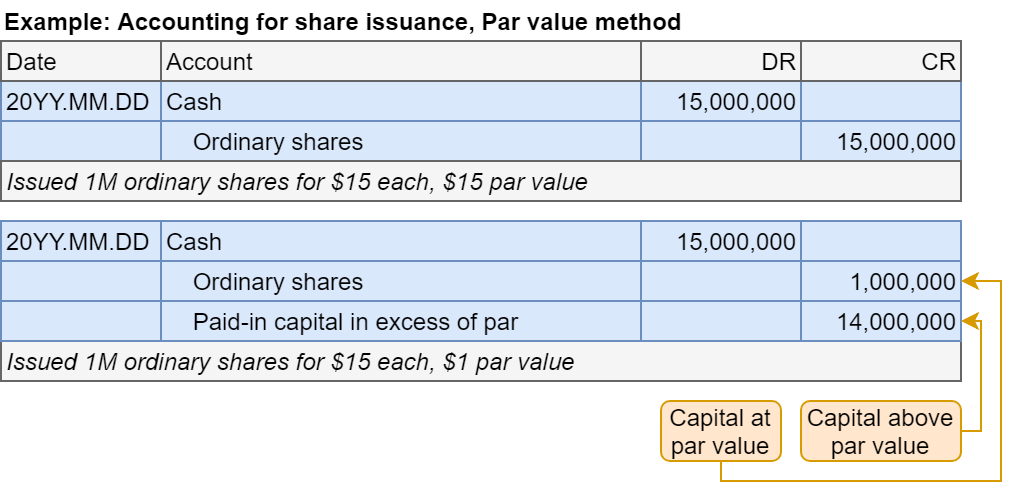
Par value
- Par value is a value of a share of stock stipulated in the corporation’s articles of incorporation
- It has no relationship with the market value of the stock (stock price)
- Ex.: Facebook has a par value of USD 0.000006/share
- It has no relationship with the market value of the stock (stock price)
- Not used in Singapore since 2005
Preferred stock
- Separate account from common stock
- Treated the same way
- Append “preferred shares” to account names
- Fixed dividend (almost always)
- First call on dividends
- Earlier call on assets than common stock
- Useful in bankruptcy
- No or limited voting rights
- Not actively traded
Accounting for preferred stock
- Using the same numbers as the common stock example
- Note: The book uses the U.S. account name, Preferred stock
Situation: The company issued 1 million preferred shares at $15 each.

We almost always treat preferred shares as equity
The exception (IAS 32) is for redeemable shares with fixed redemption date and fixed dividend payments
Treasury stock
- Common stock that has been repurchased
- Reasons for repurchasing:
- To issues incentive compensation
- Increase stock price
- Distribute cash to shareholders
- Use in trading
- Increase EPS
- Remove a shareholder (defensive)
Treasury stock: Retirement
- Retirement removes the shares from share capital entirely
Situation: The company purchased 20,000 shares at $20 each, and then retired them.
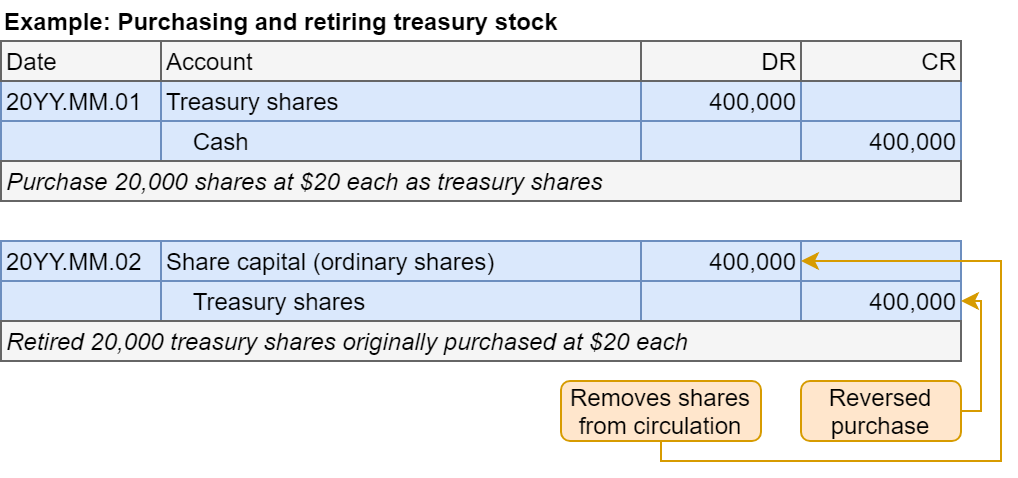
Treasury shares: contra equity account, decreasing equity
Treasury stock: Reissuing at a profit
Situation: The company purchased 20,000 shares at $20 each, and then sold them in 2 transactions: 10,000 for $25 each and 10,000 for $15 each.
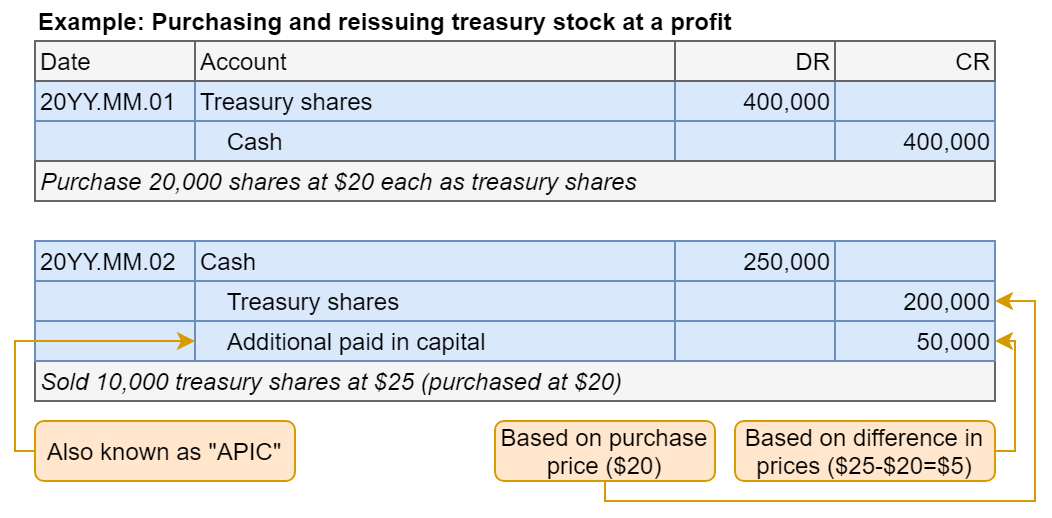

Treasury stock: Reissuing at a loss
Situation: The company purchased 20,000 shares at $20 each, and then sold them in 2 transactions: 10,000 for $15 each and 10,000 for $25 each.
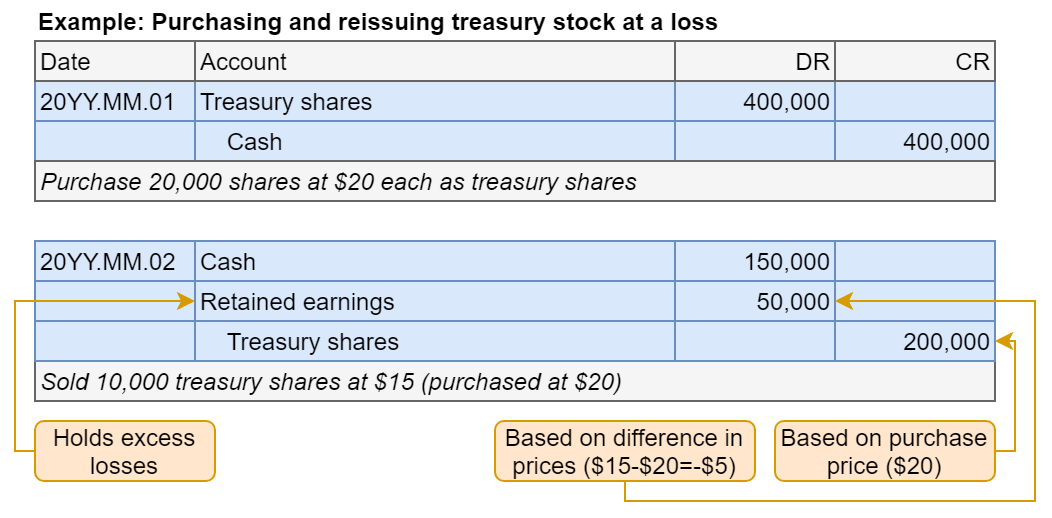

Treasury shares: Summary
- Treasury shares is a contra equity, representing the issued shares held by the firm itself
“Profit” from treasury shares
- Not considered actual profit (won’t hit the I/S)
- Can fill in prior “losses” in retained earnings
- Can add to Additional Paid-in Capital (APIC)
“Losses” from treasury shares
- Not considered an actual loss (won’t hit the I/S)
- Subtracts from APIC
- If APIC hits 0, subtract from Retained earnings
All treasury shares transactions are based on actual amounts paid (market value)
Treasury stock: Putting it all together
Situation: The company purchased 20,000 shares at $20 each, and then sold them in 3 transactions: 5,000 for $15 each, 5,000 for $26 each, and 10,000 for $18 each.
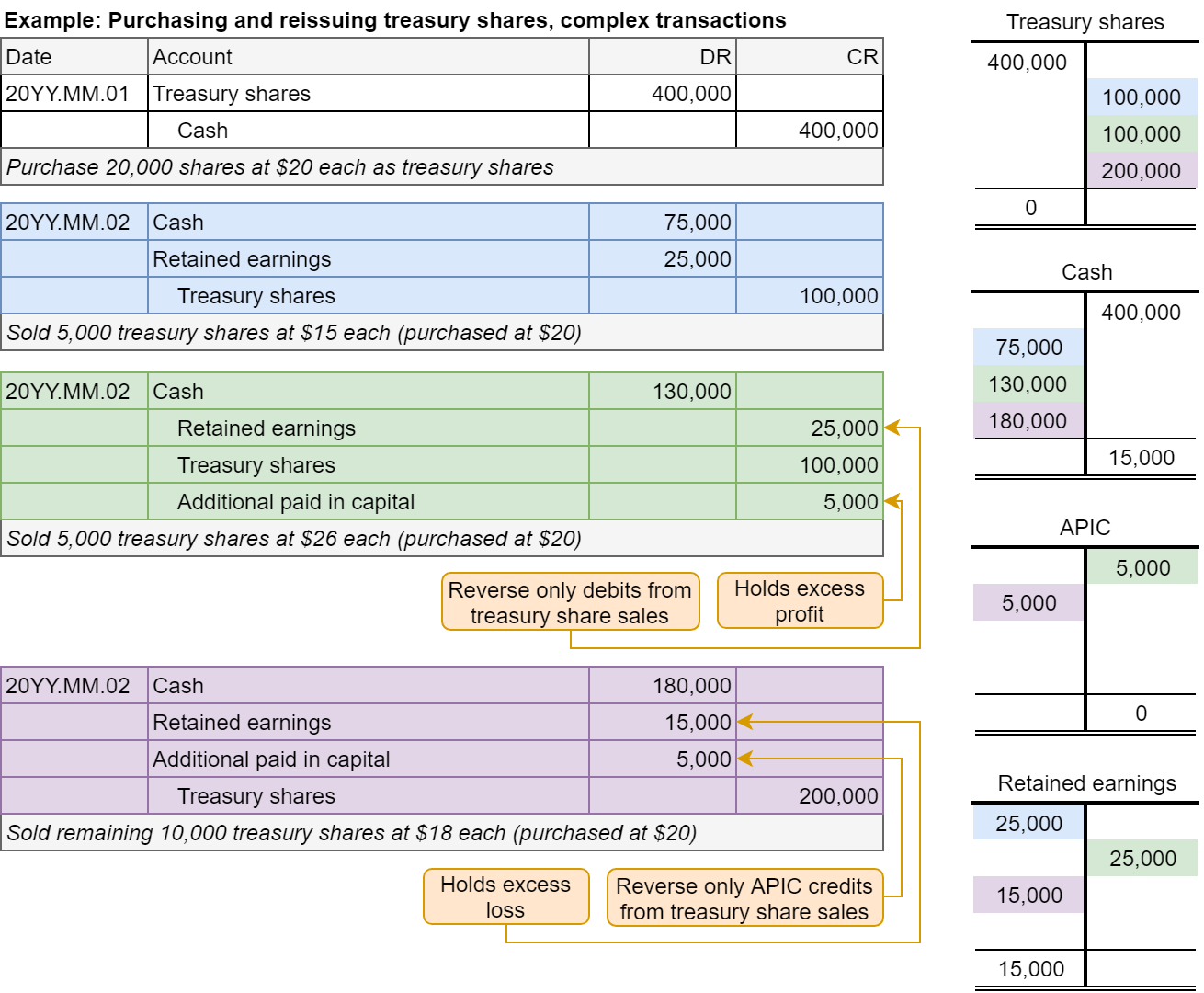
Real world Example

Dividends
- Cash dividends
- Final dividend: year end, policy voted on by shareholders
- Interim dividends: declared by board of directors
- Need to have enough retained earnings on hand to declare the dividend
- Need to have enough cash on hand to pay the dividend
- Share dividends
- Proportional distribution of shares to shareholders
- Shifts retained earnings to share capital
- Increases number of outstanding shares
Dividends timeline
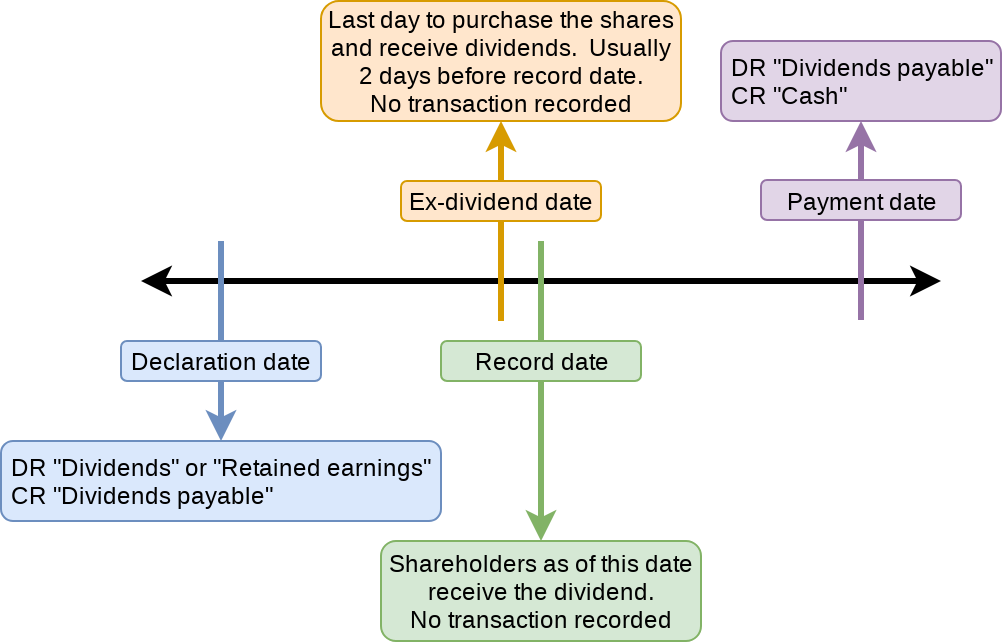
Recording cash dividends
Situation: declared $0.10 per share of dividends on Jan 1, with record date of Jan 15 and payment date of Jan 30. 100,000 shares are outstanding.
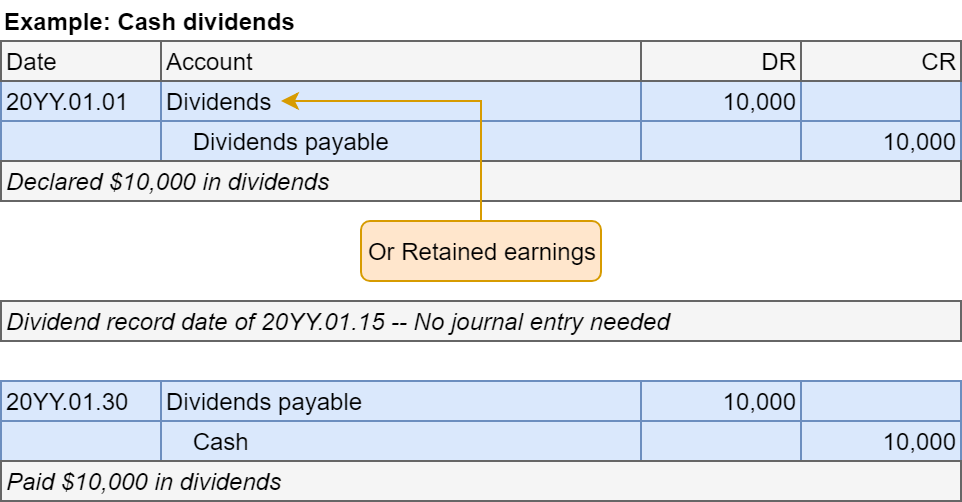
Recording share dividends
- Shifting of values within equity accounts only
- Record at market value
Situation: declared 0.05 shares per share as a share dividend on Jan 1. 100,000 shares are outstanding with a market value of $10 each.

Stock split
- Exchange all common shares at a certain ratio
- Such as a 2 for 1 stock split: receive an additional 1 share for every share owned
- Not substantively different from a stock dividend
- Just a larger change in the number of shares outstanding
- No accounting effects
- No journal entry
Summary of transactions
| Transaction | Asset (↑=DR) | Liability (↑=CR) | Equity (↑=CR) |
|---|---|---|---|
| Issue shares | ↑ | – | ↑ |
| Purchase treasury shares | ↓ | – | ↓ |
| Sell treasury shares | ↑ | – | ↑ |
| Declare dividends | – | ↑ | ↓ |
| Pay dividends | ↓ | ↓ | – |
| Issue share dividends | – | – | – |
| Stock split | – | – | – |
Practice Questions
- Take 5-10 minutes to work on this in groups
Caffeine & Co had 50,000 shares outstanding as of Jan 1, 20X8. The following transactions occurred throughout the year. Prepare the journal entries for each transaction.
- On January 30, Caffeine & Co purchased 10,000 shares for $10 per share.
- On March 30, Caffeine & Co sold 2,000 treasury shares at $8 per share.
- On April 1, Caffeine & Co declared a dividend of $0.05 per share. The date of record was April 15th, with payment on May 30th.
- On May 1, Caffeine & Co sold 6,000 treasury shares at $15 per share.
- On May 30, Caffeine & Co paid the previously declared dividend
- On October 31, Caffeine & Co sold its remaining 2,000 treasury shares at $8 per share.
For next week
- Recap the reading for this week
- Read the pages for next week
- Control Systems (Chapter 5)
- Homework to turn in next week
- Available on eLearn
- Submit on eLearn
- Practice on eLearn
- Extra Excel practice on B/S and I/S
- Practice quizzes on both F/S and equity
- Automatic feedback provided
Packages used for these slides
- curl
- kableExtra
- knitr
- quantmod
- revealjs
Custom code
# Pull and cache stock quotes
library(quantmod)
library(curl)
Quote <- function(name) {
if(has_internet()) {
quote <- getQuote(name)
saveRDS(quote, paste0(name,'_quote.rds'))
} else {
quote <- readRDS(paste0(name,'_quote.rds'))
}
quote
}